Chess: Understanding the Ruy Lopez (Open Variation) Part I
1 e4 e5 2 Nf3 Nc6 3 Bb5 a6 4 Ba4 Nf6 5 0-0 Nxe4
6 d4 b5 7 Bb3 d5 8 dxe5 Be6 9 c3 Be7 Line
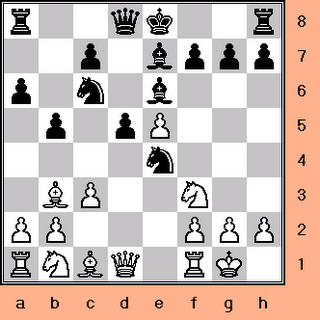
What's the game plan for White?
* Dislodge the errant e4 knight
(Bb3-c2, Nb1-d2, Nf3-d4, f2-f3)
and look for attacking possibilities
against Black's kingside.
* If possible, contain Black's
queenside counterplay via Be3
and Nb1-d2-b3.

What's the game plan for Black?
* Seek queenside counterplay through
... c5 and ... d4. On occasion, ... d4 is
playable even without ... c5.
* Execute a propitious ... f6 or ... f5
in response to White's central/kingside
activities.
Also available:
Chess: Understanding the Closed Ruy Lopez
(Flohr-Zaitsev Variation)
http://chesscoach1950.blogspot.com/2006/08/chess-understanding-closed-ruy-lopez.html
Chess: Understanding the Ruy Lopez
(Schliemann Defense)
http://chesscoach1950.blogspot.com/2006/08/chess-understanding-ruy-lopez.html
For explanations of moves 1 through 4 please refer to Understanding the Closed Ruy Lopez
http://chesscoach1950.blogspot.com/2006/01/chess-understanding-closed-ruy-lopez.html.
1 e4
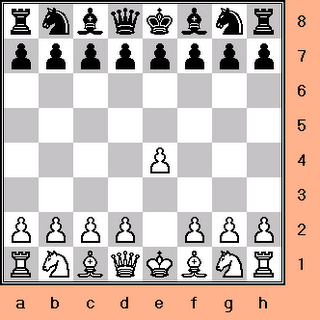
1 ... e5
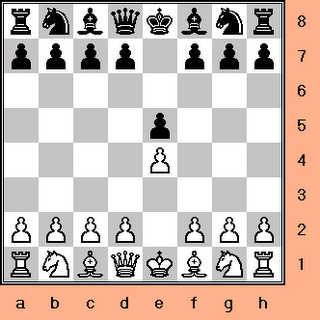
2 Nf3
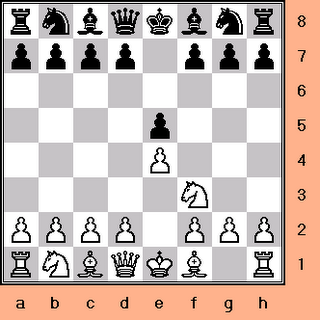
2 ... Nc6
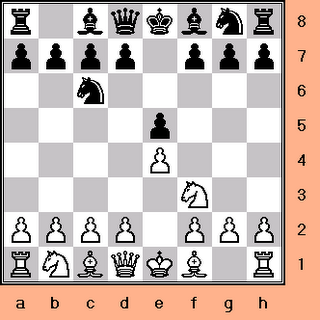
3 Bb5
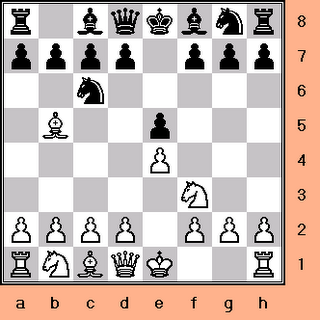
3 ... a6
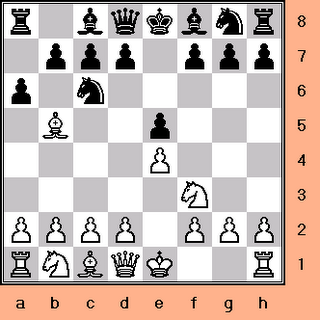
3 ... Nf6
3 ... f5
3 ... g6
3 ... Bc5
3 ... Nd4
3 ... Nge7
3 ... d6
3 ... Bb4
3 ... Be7
3 ... a5
3 ... Qe7
3 ... Qf6
3 ... Nb8
3 ... Na5
3 ... Bd6
3 ... f6
3 ... Nce7
3 ... a6 (Closed Ruy Lopez)
3 ... a6 (Open Ruy Lopez Part II)
3 ... a6 (Marshall Gambit)
3 ... d5? 4 Nxe5 Qg5 5 Nf3 Qe7 6 e5.
3 ... g5? 4 d4 Nxd4 5 Nxd4 exd4 6 Qxd4 Qf6
7 e5 Qe7 8 O-O c6.
4 Ba4
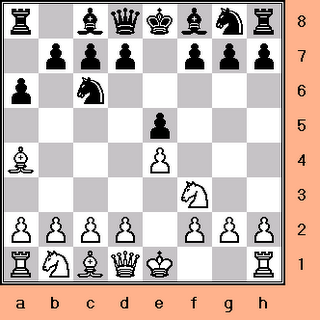
4 ... Nf6
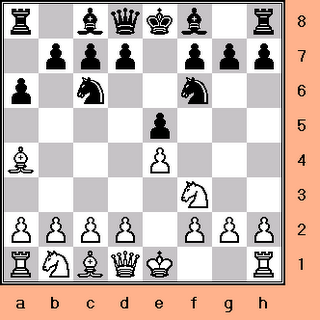
5 0-0

(i) Securing the King
(ii) Activating the h1 rook
Protecting e4 via 5 Qe2, 5 d3, or 5 Nc3
is also an option.
5 Bxc6
5 c3
5 d4 b5 6 dxe5 Nxe4 7 Bb3 Nc5 8 Bd5.
5 d4 Nxd4 6 Nxd4 exd4 7 e5 Ne4 8 Qxd4 Nc5 9 Nc3.
5 d4 Nxe4 6 Qe2 b5 7 d5 bxa4 8 Qxe4 Nb8 9 d6.
5 d4 Nxe4 6 Qe2 b5 7 Qxe4 d5 8 Qe3 bxa4 9 Nxe5 Nxe5
10 Qxe5+ Be6.
5 d4 Nxe4 6 Qe2 f5 7 d5 Na7 8 Nxe5 Qf6 9 Nd3.
5 d4 exd4 6 O-O Nxe4 7 Re1 d5 8 Nxd4 Bd6 9 Nxc6 Bxh2+
10 Kh1 Qh4 11 Rxe4+ dxe4 12 Qd8+ Qxd8 13 Nxd8+ Kxd8
14 Kxh2 Be6.
5 d4 exd4 6 O-O Nxe4 7 Re1 d5 8 Nxd4 Bd6 9 Qf3 O-O
10 Nxc6 bxc6 11 Bxc6 Bxh2+ 12 Kxh2 Qd6+ 13 Bf4 Qxc6
14 Nc3 Bf5.
5 d4 exd4 6 O-O Nxe4 7 Re1 d5 8 Nxd4 Bd6 9 Qh5 O-O
10 Nxc6 bxc6 11 Bxc6 Rb8 12 Qxd5 Bxh2+ 13 Kf1.
5 d4 exd4 6 O-O Nxe4 7 Re1 d5 8 Nxd4 Bd6 9 f3 Bxh2+
10 Kxh2 Qh4+ 11 Kg1 Qf2+ 12 Kh1 Qh4+.
5 d4 exd4 6 O-O Nxe4 7 Re1 d5 8 Nxd4 Bd6 9 f3 Bxh2+
10 Kf1 Qf6 11 Nxc6 O-O.
5 d4 exd4 6 O-O Nxe4 7 Re1 f5 8 Nxd4 Qh4 9 g3 Qf6
10 Bxc6 bxc6 11 f3 Bc5 12 c3 O-O 13 fxe4 fxe4.
5 d4 exd4 6 O-O Nxe4 7 Re1 f5 8 Nxd4 b5 9 Bb3 Qh4
10 g3 Qf6 11 Nxc6 dxc6 12 f3.
5 d4 exd4 6 O-O Nxe4 7 Re1 f5 8 Nxd4 b5 9 Bb3 Nxd4
10 Qxd4 Bb7 11 f3.
5 ... Nxe4
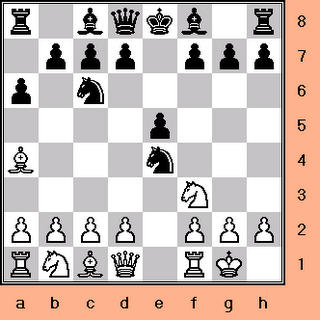
Inaugurating the Open Variation of the Ruy
Lopez. Black is now a pawn up. However, he'll
soon be forced to return it.
5 ... Be7
5 ... b5
5 ... Bbc5
5 ... d6
5 ... Bd6
6 d4!
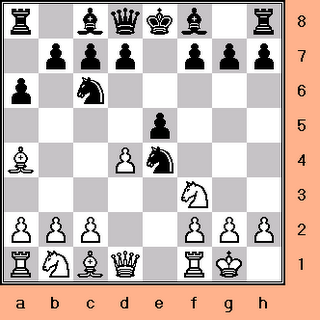
(i) Attacking the e5 pawn a second time
(ii) Threatening d4-d5 in order to attack the c6 knight
and cramp Black's game in the center.
6 Re1
6 Bxc6
6 Qe2
6 Nc3
6 ... b5
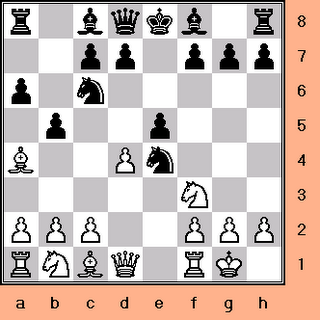
Black wants to deter d4-d5 by playing ... d7-d5.
However, an immediate 6 ... d5 would give White
a powerful attack against the Black monarch:
7 Nxe5
Attacking the c6 knight in conjunction with
the a4 bishop
7 ... Bd7
Protecting the knight a second time
8 Nxf7
And the onslaught begins!
8 ... Kxf7 9 Qh5+ g6 10 Qxd5+ Kg7 11 Qxe4.
7 Nxe5 Bd7 8 Nxf7 Kxf7 9 Qh5+ Ke6 10 Bb3
10 ... Be8 11 Qg4+ Ke7 12 Re1.
7 Nxe5 Bd7 8 Nxf7 Kxf7 9 Qh5+ Ke6 10 Bb3
10 ... Nb4 11 Re1.
So, Black first eliminates this danger by
chasing away the bishop.
6 ... exd4 gives White a small advantage as
in Capablanca-Ed. Lasker, New York 1915:
7 Re1 d5 8 Nxd4 Bd6 9 Nxc6 Bxh2+ 10 Kh1!
10 ... Qh4 11 Rxe4+ dxe4 12 Qxd8+ Qxd8
13 Nxd8 Kxd8 14 Kxh2.
6 ... Be7
6 ... exd4
6 ... d5
7 Bb3
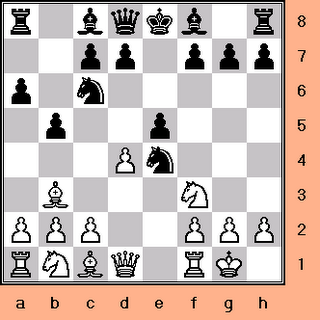
7 Nxe5
7 d5
7 ... d5
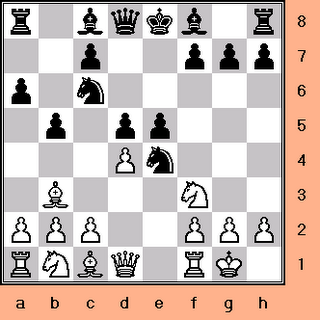
7 ... Be7
7 ... exd4
8 dxe5
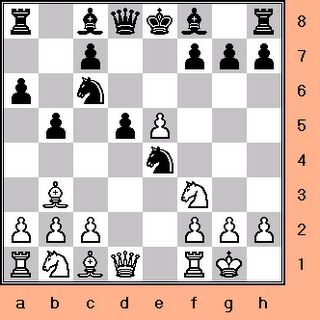
Gaining his pawn back and attacking d5 a second time.
8 Nxe5
8 a4
8 c4
8 Nc3
8 Re1
8 ... Be6
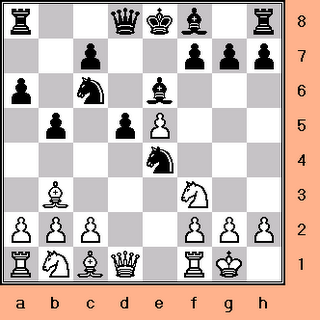
Protecting d5.
8 ... Bd6
8 ... Ne7
9 c3
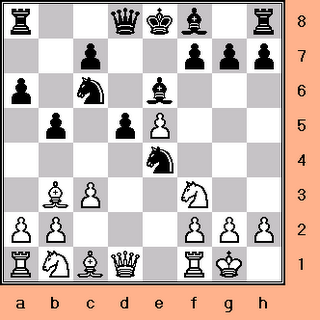
Keeping a tab on d4 and providing the bishop with
a retreat square on c2. Once there, the bishop can
help to remove Black's knight from e4 and fire down
at his kingside along the b1-h7 diagonal.
9 Nbd2
9 Be3
9 Qe2
9 a4
9 Re1
9 Nc3
9 ... Be7

9 ... Bc5
9 ... Nc5
9 ... Be7 10 a3 O-O 11 Nbd2 Qd7 12 Nxe4 dxe4
13 Qxd7 Bxd7 14 Nd2 e3 15 Nf3 exf2+ 16 Kxf2 Rad8
17 Be3 a5.
9 ... Be7 10 Re1 Qd7 11 Nbd2 Nc5 12 Bc2 O-O
13 b4 Na4 14 Nb1 f5 15 Bxa4 bxa4
16 Nbd2 f4.
9 ... Be7 10 Nbd2 Nc5 11 Bc2 O-O 12 Nb3 Nxb3
13 axb3 f5 14 Qd3 Qe8 15 Be3 a5 16 Rfd1.
9 ... Be7 10 Bf4 O-O 11 Nd4 Qd7 12 Nd2 Nc5
13 Bc2 f6 14 Qh5 g6 15 Bxg6.
9 ... Be7 10 Bc2 O-O 11 Nbd2 f5 12 Nd4 Qd7
13 Nxc6 Qxc6 14 Nb3 Bd7 15 Nd4 Qg6.
9 ... Be7 10 Nd4 Nxe5 11 Qe2 Bg4 12 f3 c5
13 fxg4 cxd4 14 cxd4 Nc6 15 Qe3 O-O
16 Rf5 Nb4.
9 ... Be7 10 a4 Nc5 11 Bc2 O-O 12 axb5 axb5
13 Rxa8 Qxa8 14 Be3 Ne4 15 Qd3 f5
16 Bb3 Na5.
9 ... Be7 10 Qe2 Qd7 11 Bc2 O-O 12 Nd4 f5
13 f3 Nc5 14 b4 Nb7 15 a3 Nxd4 16 cxd4.
9 ... Be7 10 Qe1 O-O 11 Bc2 Qd7 12 Bxe4 dxe4
13 Qxe4 Rad8 14 Nbd2 Bd5 15 Qe3 Qg4.
10 Be3
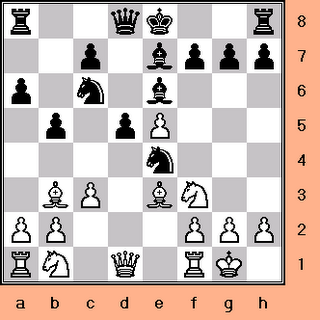
10 Nbd2
10 Bc2
10 Qe2
10 Re1
10 Bf4
10 Nd4
10 h3
10 Be3 O-O 11 Nbd2 Nc5 12 Bc2 Nd7
13 Re1 Bg4 14 Bf4 Re8 15 Qb1 h6 16 b4.
10 ... Qd7
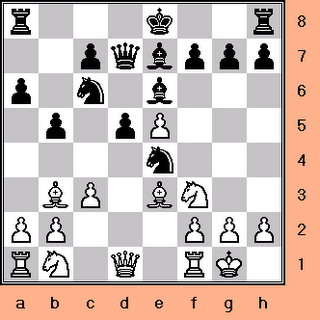
10 ... Nc5
10 ... O-O
10 ... Na5
11 Nbd2
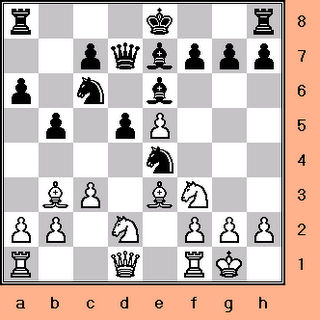
11 Re1
11 ... Rd8
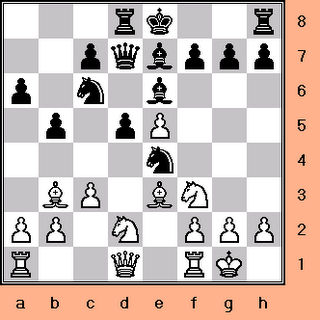
11 ... O-O
11 ... Nc5
11 ... Nxd2
11 ... Bg4
12 Re1
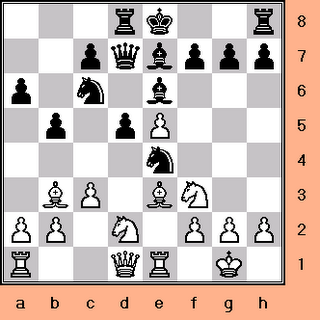
12 h3
12 Nxe4
12 Nd4
12 ... O-O
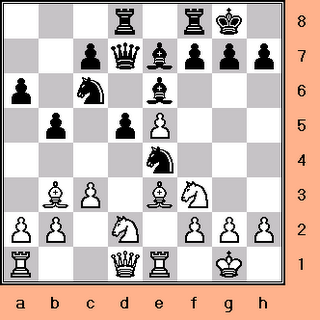
12 ... Nxd2
13 Bc2
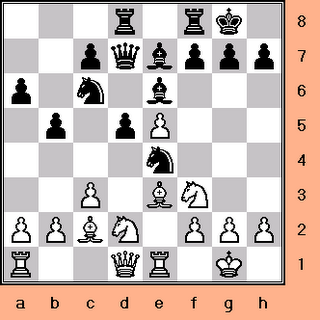
13 a4
13 Nd4
13 ... Nxd2
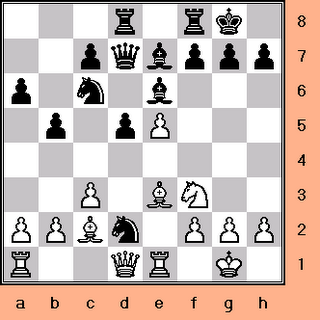
13 ... f5
13 ... Bf5
14 Qxd2
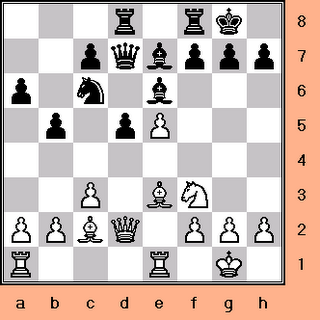
14 ... Bf5
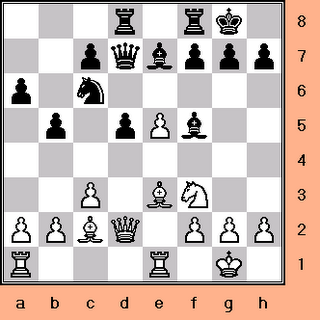
14 ... Bg4
15 Rad1
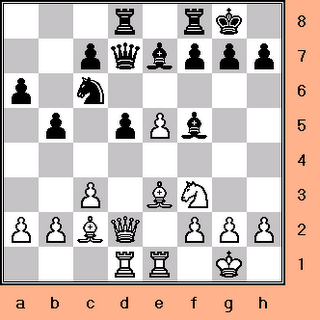
15 Bxf5
15 ... Rfe8
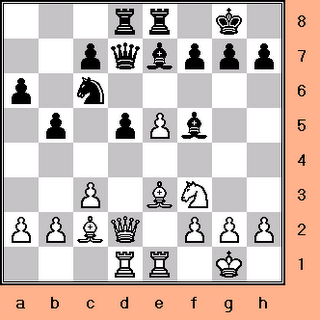
15 ... Bxc2
15 ... Bg6
16 h3
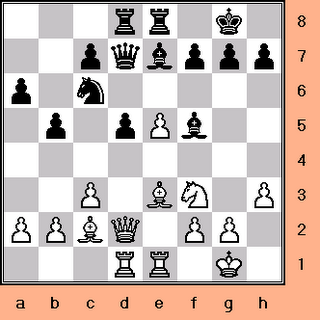
16 Bf4
16 ... h6
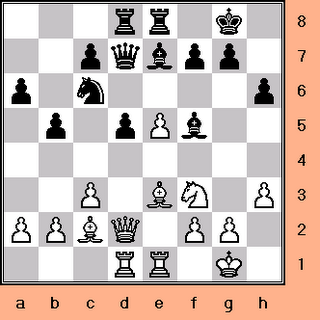
16 ... Qe6
17 Bf4
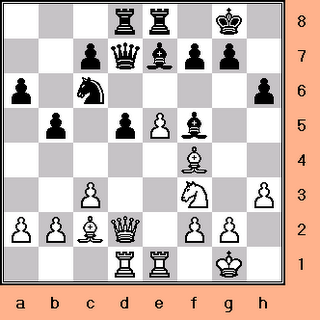
17 ... Bf8
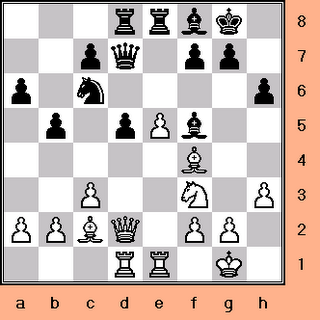
17 ... Qe6
18 Bg3

18 ... Bxc2
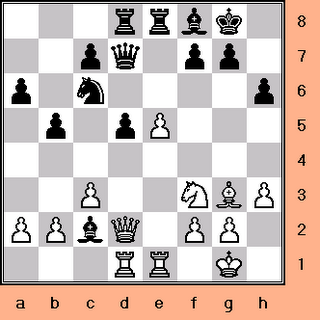
19 Qxc2
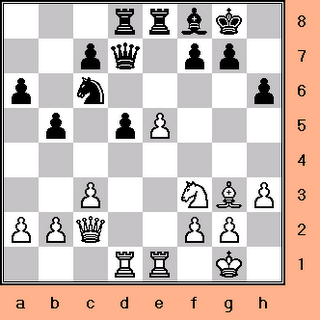
19 ... Qe6
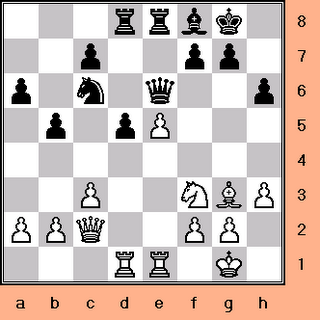
20 Nd4
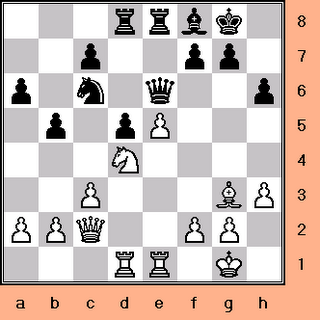
20 ... Nxd4
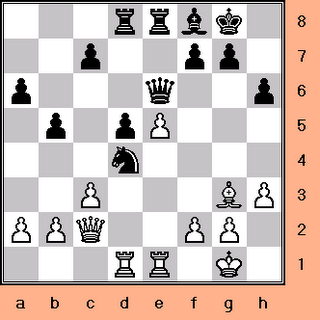
21 cxd4
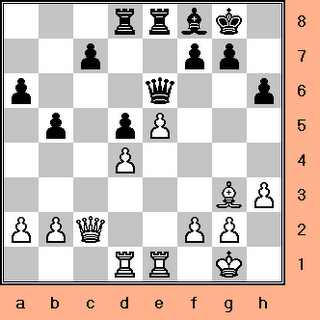
By ChessCoach@care2.com
6 d4 b5 7 Bb3 d5 8 dxe5 Be6 9 c3 Be7 Line

What's the game plan for White?
* Dislodge the errant e4 knight
(Bb3-c2, Nb1-d2, Nf3-d4, f2-f3)
and look for attacking possibilities
against Black's kingside.
* If possible, contain Black's
queenside counterplay via Be3
and Nb1-d2-b3.

What's the game plan for Black?
* Seek queenside counterplay through
... c5 and ... d4. On occasion, ... d4 is
playable even without ... c5.
* Execute a propitious ... f6 or ... f5
in response to White's central/kingside
activities.
Also available:
Chess: Understanding the Closed Ruy Lopez
(Flohr-Zaitsev Variation)
http://chesscoach1950.blogspot.com/2006/08/chess-understanding-closed-ruy-lopez.html
Chess: Understanding the Ruy Lopez
(Schliemann Defense)
http://chesscoach1950.blogspot.com/2006/08/chess-understanding-ruy-lopez.html
For explanations of moves 1 through 4 please refer to Understanding the Closed Ruy Lopez
http://chesscoach1950.blogspot.com/2006/01/chess-understanding-closed-ruy-lopez.html.
1 e4

1 ... e5

2 Nf3

2 ... Nc6

3 Bb5

3 ... a6

3 ... Nf6
3 ... f5
3 ... g6
3 ... Bc5
3 ... Nd4
3 ... Nge7
3 ... d6
3 ... Bb4
3 ... Be7
3 ... a5
3 ... Qe7
3 ... Qf6
3 ... Nb8
3 ... Na5
3 ... Bd6
3 ... f6
3 ... Nce7
3 ... a6 (Closed Ruy Lopez)
3 ... a6 (Open Ruy Lopez Part II)
3 ... a6 (Marshall Gambit)
3 ... d5? 4 Nxe5 Qg5 5 Nf3 Qe7 6 e5.
3 ... g5? 4 d4 Nxd4 5 Nxd4 exd4 6 Qxd4 Qf6
7 e5 Qe7 8 O-O c6.
4 Ba4

4 ... Nf6

5 0-0

(i) Securing the King
(ii) Activating the h1 rook
Protecting e4 via 5 Qe2, 5 d3, or 5 Nc3
is also an option.
5 Bxc6
5 c3
5 d4 b5 6 dxe5 Nxe4 7 Bb3 Nc5 8 Bd5.
5 d4 Nxd4 6 Nxd4 exd4 7 e5 Ne4 8 Qxd4 Nc5 9 Nc3.
5 d4 Nxe4 6 Qe2 b5 7 d5 bxa4 8 Qxe4 Nb8 9 d6.
5 d4 Nxe4 6 Qe2 b5 7 Qxe4 d5 8 Qe3 bxa4 9 Nxe5 Nxe5
10 Qxe5+ Be6.
5 d4 Nxe4 6 Qe2 f5 7 d5 Na7 8 Nxe5 Qf6 9 Nd3.
5 d4 exd4 6 O-O Nxe4 7 Re1 d5 8 Nxd4 Bd6 9 Nxc6 Bxh2+
10 Kh1 Qh4 11 Rxe4+ dxe4 12 Qd8+ Qxd8 13 Nxd8+ Kxd8
14 Kxh2 Be6.
5 d4 exd4 6 O-O Nxe4 7 Re1 d5 8 Nxd4 Bd6 9 Qf3 O-O
10 Nxc6 bxc6 11 Bxc6 Bxh2+ 12 Kxh2 Qd6+ 13 Bf4 Qxc6
14 Nc3 Bf5.
5 d4 exd4 6 O-O Nxe4 7 Re1 d5 8 Nxd4 Bd6 9 Qh5 O-O
10 Nxc6 bxc6 11 Bxc6 Rb8 12 Qxd5 Bxh2+ 13 Kf1.
5 d4 exd4 6 O-O Nxe4 7 Re1 d5 8 Nxd4 Bd6 9 f3 Bxh2+
10 Kxh2 Qh4+ 11 Kg1 Qf2+ 12 Kh1 Qh4+.
5 d4 exd4 6 O-O Nxe4 7 Re1 d5 8 Nxd4 Bd6 9 f3 Bxh2+
10 Kf1 Qf6 11 Nxc6 O-O.
5 d4 exd4 6 O-O Nxe4 7 Re1 f5 8 Nxd4 Qh4 9 g3 Qf6
10 Bxc6 bxc6 11 f3 Bc5 12 c3 O-O 13 fxe4 fxe4.
5 d4 exd4 6 O-O Nxe4 7 Re1 f5 8 Nxd4 b5 9 Bb3 Qh4
10 g3 Qf6 11 Nxc6 dxc6 12 f3.
5 d4 exd4 6 O-O Nxe4 7 Re1 f5 8 Nxd4 b5 9 Bb3 Nxd4
10 Qxd4 Bb7 11 f3.
5 ... Nxe4

Inaugurating the Open Variation of the Ruy
Lopez. Black is now a pawn up. However, he'll
soon be forced to return it.
5 ... Be7
5 ... b5
5 ... Bbc5
5 ... d6
5 ... Bd6
6 d4!

(i) Attacking the e5 pawn a second time
(ii) Threatening d4-d5 in order to attack the c6 knight
and cramp Black's game in the center.
6 Re1
6 Bxc6
6 Qe2
6 Nc3
6 ... b5

Black wants to deter d4-d5 by playing ... d7-d5.
However, an immediate 6 ... d5 would give White
a powerful attack against the Black monarch:
7 Nxe5
Attacking the c6 knight in conjunction with
the a4 bishop
7 ... Bd7
Protecting the knight a second time
8 Nxf7
And the onslaught begins!
8 ... Kxf7 9 Qh5+ g6 10 Qxd5+ Kg7 11 Qxe4.
7 Nxe5 Bd7 8 Nxf7 Kxf7 9 Qh5+ Ke6 10 Bb3
10 ... Be8 11 Qg4+ Ke7 12 Re1.
7 Nxe5 Bd7 8 Nxf7 Kxf7 9 Qh5+ Ke6 10 Bb3
10 ... Nb4 11 Re1.
So, Black first eliminates this danger by
chasing away the bishop.
6 ... exd4 gives White a small advantage as
in Capablanca-Ed. Lasker, New York 1915:
7 Re1 d5 8 Nxd4 Bd6 9 Nxc6 Bxh2+ 10 Kh1!
10 ... Qh4 11 Rxe4+ dxe4 12 Qxd8+ Qxd8
13 Nxd8 Kxd8 14 Kxh2.
6 ... Be7
6 ... exd4
6 ... d5
7 Bb3

7 Nxe5
7 d5
7 ... d5

7 ... Be7
7 ... exd4
8 dxe5

Gaining his pawn back and attacking d5 a second time.
8 Nxe5
8 a4
8 c4
8 Nc3
8 Re1
8 ... Be6

Protecting d5.
8 ... Bd6
8 ... Ne7
9 c3

Keeping a tab on d4 and providing the bishop with
a retreat square on c2. Once there, the bishop can
help to remove Black's knight from e4 and fire down
at his kingside along the b1-h7 diagonal.
9 Nbd2
9 Be3
9 Qe2
9 a4
9 Re1
9 Nc3
9 ... Be7

9 ... Bc5
9 ... Nc5
9 ... Be7 10 a3 O-O 11 Nbd2 Qd7 12 Nxe4 dxe4
13 Qxd7 Bxd7 14 Nd2 e3 15 Nf3 exf2+ 16 Kxf2 Rad8
17 Be3 a5.
9 ... Be7 10 Re1 Qd7 11 Nbd2 Nc5 12 Bc2 O-O
13 b4 Na4 14 Nb1 f5 15 Bxa4 bxa4
16 Nbd2 f4.
9 ... Be7 10 Nbd2 Nc5 11 Bc2 O-O 12 Nb3 Nxb3
13 axb3 f5 14 Qd3 Qe8 15 Be3 a5 16 Rfd1.
9 ... Be7 10 Bf4 O-O 11 Nd4 Qd7 12 Nd2 Nc5
13 Bc2 f6 14 Qh5 g6 15 Bxg6.
9 ... Be7 10 Bc2 O-O 11 Nbd2 f5 12 Nd4 Qd7
13 Nxc6 Qxc6 14 Nb3 Bd7 15 Nd4 Qg6.
9 ... Be7 10 Nd4 Nxe5 11 Qe2 Bg4 12 f3 c5
13 fxg4 cxd4 14 cxd4 Nc6 15 Qe3 O-O
16 Rf5 Nb4.
9 ... Be7 10 a4 Nc5 11 Bc2 O-O 12 axb5 axb5
13 Rxa8 Qxa8 14 Be3 Ne4 15 Qd3 f5
16 Bb3 Na5.
9 ... Be7 10 Qe2 Qd7 11 Bc2 O-O 12 Nd4 f5
13 f3 Nc5 14 b4 Nb7 15 a3 Nxd4 16 cxd4.
9 ... Be7 10 Qe1 O-O 11 Bc2 Qd7 12 Bxe4 dxe4
13 Qxe4 Rad8 14 Nbd2 Bd5 15 Qe3 Qg4.
10 Be3

10 Nbd2
10 Bc2
10 Qe2
10 Re1
10 Bf4
10 Nd4
10 h3
10 Be3 O-O 11 Nbd2 Nc5 12 Bc2 Nd7
13 Re1 Bg4 14 Bf4 Re8 15 Qb1 h6 16 b4.
10 ... Qd7

10 ... Nc5
10 ... O-O
10 ... Na5
11 Nbd2

11 Re1
11 ... Rd8

11 ... O-O
11 ... Nc5
11 ... Nxd2
11 ... Bg4
12 Re1

12 h3
12 Nxe4
12 Nd4
12 ... O-O

12 ... Nxd2
13 Bc2

13 a4
13 Nd4
13 ... Nxd2

13 ... f5
13 ... Bf5
14 Qxd2

14 ... Bf5

14 ... Bg4
15 Rad1

15 Bxf5
15 ... Rfe8

15 ... Bxc2
15 ... Bg6
16 h3

16 Bf4
16 ... h6

16 ... Qe6
17 Bf4

17 ... Bf8

17 ... Qe6
18 Bg3

18 ... Bxc2

19 Qxc2

19 ... Qe6

20 Nd4

20 ... Nxd4

21 cxd4

By ChessCoach@care2.com

0 Comments:
Post a Comment
<< Home